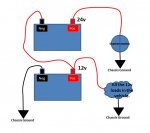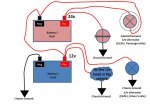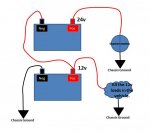Good news!
There it is...

I traced the circuit (found out that 24 volts actually goes INTO the PCB via pin 7 (orange wire), through the Gen 2 bulb, and OUT via pin 6 (BRN/RED wire) to the relay.
I don't know where I was getting that 12 volts there or why, but, it disappeared. I checked for continuity between all wires and the Gen 2 relay socket. Then, turned on the key, had 12 volts at the pink/black wire, 24 volts at the brown/red wire, ground was good, and continuity from the 24V output on the Gen 2 relay socket to the diode.
Everything looked good, so, I decided to try the relay (note: I had replaced the Gen 2 relay last year and bought spares). I paused, and before putting the one I had taken out back in, I decided to go into the garage, get a new one, and try it. I plugged it in, turned on the key, and WHOLLA! First time I'd seen my Gen 2 light in almost 4 years. I don't know how or when that relay went bad (maybe it was bad right out of the box), but, I'm glad I decided to try a new one!
I charged up the batteries for good measure and fired it up. I'd recently done the Doghead starter relay mod, paired that with my recent addition of an electric fuel pump, and WOW--did it ever spin over nice. Gen 2 light went out with Gen 1 and the Voltmeter was well into the green...
Thanks for all the help, Gents! I can't even begin to describe the elation... Now, it's time to put it all back together again.
After all this messing about, I can say one thing with confidence--I am now certain that I know and understand the charging system and it's related circuits quite well. I made lots of mistakes along the way, but, I learned much, much more. Hopefully, this will give me the ability to help someone else with their troubles...
I'm not even sure what it is EXACTLY that fixed the original Gen 2 light--it may have been the first or second rebuild, the last diode trio replacement, OR, could it have been that the replacement GEN 2 relay was bad? Maybe it was both.

I'll never really know, but, I do know how I'll go about figuring it out next time--hopefully for someone else!!!






 I traced the circuit (found out that 24 volts actually goes INTO the PCB via pin 7 (orange wire), through the Gen 2 bulb, and OUT via pin 6 (BRN/RED wire) to the relay.
I traced the circuit (found out that 24 volts actually goes INTO the PCB via pin 7 (orange wire), through the Gen 2 bulb, and OUT via pin 6 (BRN/RED wire) to the relay. 
 I'll never really know, but, I do know how I'll go about figuring it out next time--hopefully for someone else!!!
I'll never really know, but, I do know how I'll go about figuring it out next time--hopefully for someone else!!!